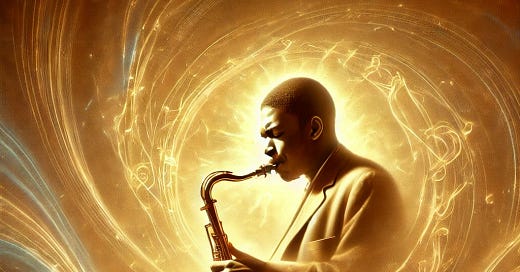Last week marked the 60th anniversary of John Coltrane's A Love Supreme. As a rabbi, I'm often asked about powerful spiritual experiences.
When I posed this question to my congregation, their answers surprised me—and yet didn't.
Yes, they mentioned weddings, baby namings, and holidays with loved ones. But one theme kept emerging: the power of music.
Almost every transformative spiritual moment—aside from those in nature—contained a musical element. A song. A melody. A voice raised in prayer.
A Love Supreme as Spiritual Expression
For many, including my father, Coltrane's A Love Supreme serves as exactly this kind of spiritual vehicle.
It's more than music—it's a meditation, a prayer, an expression of yearning for divine connection.
The album uses the language of jazz to offer what we Jews call kavannah—holy intention. Coltrane uses his saxophone to elevate sound into a vessel for encountering the Infinite.
How It Happened
In 1957, Coltran overcame a severe addiction to heroin. Over the next couple of years, he traveled and read extensively in different spiritual traditions.
A Love Supreme, recorded in 1964, emerged as his testimony of gratitude and struggle—not unlike King David's Psalms.
The album unfolds as a four-part suite: Acknowledgment, Resolution, Pursuance, and Psalm.
This structure deeply resonates with Jewish thought, where spiritual growth happens in stages—and not always linearly.
We move forward and back, like the angels on Jacob's ladder (Genesis 28:12).
The Four Movements Through a Jewish Lens
Acknowledgment: A Musical Shema
The album opens with a hypnotic bass motif that grounds everything that follows. Coltrane eventually chants a four-note phrase: "A Love Supreme."
To my ears, this moment echoes our Shema—Judaism's central declaration of faith.
Just as we proclaim, "Hear, O Israel, the Lord is our God, the Lord is One," Coltrane affirms his devotion to a singular, all-encompassing Love. It's a moment of profound surrender.
Resolution: Wrestling with the Divine
The second movement reminds me of the Amidah, our standing prayer. Coltrane’s saxophone pushes against boundaries, searching and wrestling like Jacob with the angel.
It’s the sound of spiritual struggle made manifest.
Faith is not always easy. The journey toward the divine often involves doubt, questioning, and persistence. Coltrane’s playing in Resolution captures that tension beautifully.
Pursuance: The Call to Action
This section builds with prophetic intensity. Like Isaiah or Jeremiah, it demands we move beyond passive spirituality into active engagement.
The prophets called Israel to justice. Coltrane's horn urges us toward something higher as well, something demanding, something only God, the Love Supreme, can provide.
Psalm: A Wordless Prayer
The final movement, Psalm, speaks to me as a wordless prayer. Just as the shofar's blast on Rosh Hashanah carries meanings no words can capture, Coltrane's saxophone becomes a vessel for the soul's deepest yearnings.
In Jewish mysticism, we understand that some truths transcend language. The deepest experiences—whether in prayer, meditation, or music—exist beyond words, felt more than spoken
Music as Prayer
Sixty years later, A Love Supreme still shows us how art can become prayer, how music can lift us beyond ourselves.
It reminds us that the spiritual journey—whether through Torah or music—is always about reaching toward something greater than ourselves.
That's what I hear in Coltrane's masterpiece. What do you hear?
Listen to the full album here:






Beautiful. Thank you for this!
Evan: Brilliant and Right On. Thanks